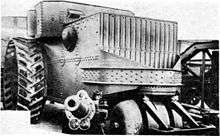Steam Wheel Tank
| Steam Wheel Tank | |
|---|---|
 1918 photograph of the Steam Wheel Tank (rear view) | |
| Place of origin |
|
| Specifications | |
| Weight | 17 tons |
| Length | 22 ft 3 in |
| Width | 10 ft 1 in |
| Height | 9 ft 10 in |
| Crew | 6 |
|
| |
| Armor | .23" to .63" |
Main armament | 1× 75mm howitzer |
Secondary armament | 6× .30 caliber machine guns |
| Engine | 2 steam |
Operational range | ? |
The Steam Wheel Tank was an early U.S.-produced tank built by the Holt Manufacturing Company (now Caterpillar Inc.). Developed sometime between late 1916 and early 1917, it was the third tank to be designed in the U.S. A prototype was completed in February 1918 and was evaluated between March and May 1918 at Aberdeen Proving Ground.
It was also known as the Holt Steam Tank and the Holt 150-ton Field Monitor (a false name intended to hide its design features from Germany).
Design
The Steam Wheel Tank had two eight-foot diameter wheels with three-foot-wide treads, located at the front of the vehicle. These wheels were composed of pressed-steel sheets and were the same wheels as were used on Holt agricultural machinery of the period. At the rear was a third wheel, a four-foot diameter roller used for steering. A small plate was attached to this roller to assist in crossing trenches. Both front wheels were driven by individual power units which consisted of a Doble two-cylinder 75 horsepower steam engine and a Doble kerosene-fired boiler.
The vehicle's main armament was a 2.95" (75 mm) mountain howitzer mounted low in the front. A .30 caliber Browning machine gun was carried in a ball mount on each hull side. Its riveted armour plating was between six and fifteen millimetres thick.
References
- Rigsby, Tim. "Steam Wheel Tank". landships.info. Retrieved July 7, 2016.
